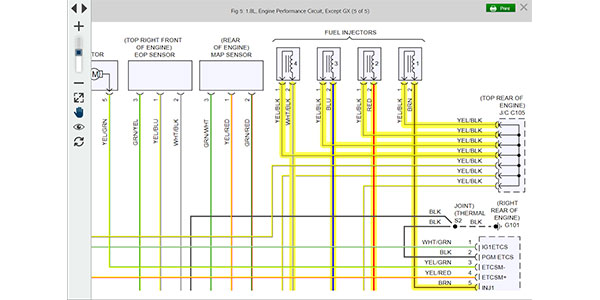By Gary Goms
Contributing Writer
Have muffler inspections become a low-priority undercar service in your shop? With the introduction of stainless-steel exhaust systems into the import market, it’s easy to forget that muffler and related exhaust parts sales are still a lucrative service that can enhance any profit and loss statement.
Muffler replacements can be profitable at any skill or specialty level because they require little tooling and training expense. Better still, all vehicles eventually need a muffler replacement and the sale is usually awarded to the shop that makes the initial recommendation.
Unfortunately for our customers, if the muffler hasn’t broken off the exhaust pipe and the external shell doesn’t resemble a piece of Swiss cheese, we’ll give it a pass.
Of course, there is an excuse for our lackadaisical approach to muffler inspections: modern exhaust systems usually last well past the 100,000-mile mark and are, on the whole, trouble-free.
On the other hand, low-speed driving and exposure to salt-laden winter roads can reduce muffler life well below normal expectations.
So, if you want to add an extra profit to an undercar service invoice, don’t forget that muffler replacements are fast, easy and normally don’t interrupt a busy work schedule!
 Muffler Inspections
Muffler Inspections
Any serious undercar muffler inspection should go beyond looking at the obvious Swiss cheese rust perforations. The muffler and exhaust system should be inspected whenever the vehicle comes in for an undercar service, such as lubrication service or a brake, clutch, fuel filter or fuel pump replacement. For example, sooty deposits on the exterior of the muffler reveal exhaust perforations or leaks in the exhaust pipe-to-muffler connection.
Traces of black soot or rust along the crimped lateral and end-cap seams might also indicate a potential muffler failure.
For a more in-depth inspection of a muffler, use a rubber hammer to tap the muffler along the end cap area and listen for loose internal parts. In some cases, loose internal tubing or baffling may be causing an annoying rattling noise or, in a worst-case scenario, a partial blockage of the muffler outlet. The overall condition of the muffler housing and exhaust pipe can be estimated by lightly tapping their exteriors with a small ball-peen hammer. If the metal dents easily or sounds wooden, the muffler or pipe is usually nearing the end of its useful service life.
Muffler Restriction
Whenever an air/fuel ratio or loss of power issue is encountered, the muffler and related exhaust system should be tested for restriction. One of the most often overlooked muffler problems occurs when the catalytic converter begins to deteriorate and clog the muffler’s internal baffling with small bits of catalytic media. In these cases, it’s difficult to evaluate the muffler’s performance by just testing the vehicle’s apparent throttle response and power.
When backpressure increases beyond an acceptable level on computer-controlled fuel systems, several drivability complaints might manifest themselves. The fuel system may tend to richen due to reduced intake manifold vacuum on systems using a manifold absolute pressure (MAP) sensor to measure intake manifold vacuum.
On systems using a mass air flow sensor (MAF) to measure intake air, air/fuel mixtures are calibrated based on operating parameters like indicated intake airflow, engine speed, and throttle opening, among others.
Depending upon how the sensor system is prioritized, an exhaust restriction may cause changes in the air/fuel mixture ratio or fuel trim numbers displayed on a shop’s computer scanner tool.
Last, it’s important to understand that some OE vehicle systems are calibrated to operate with specific levels of backpressure. Increasing or reducing backpressure may force exhaust gas recirculation valves to operate beyond their initial range of calibration. Consequently, it’s important to understand how a particular system operates before making assumptions on what the maximum level of backpressure may be.
Backpressure Testing
If the catalytic converter has failed, it’s important to use a vacuum gauge or exhaust pressure tester to evaluate exhaust backpressure. The quickest method of evaluating exhaust backpressure is to attach a high-quality vacuum gauge that is both accurate and responsive to an intake manifold vacuum source. In general, the exhaust shouldn’t develop a no-load backpressure of more than 3 or 4 psi when the throttle is held at a constant 2,500-rpm engine speed. If the pressure exceeds 5 psi, the muffler certainly deserves a more thorough evaluation, because this value will increase dramatically at highway speeds and full-throttle loads. If the vehicle has been modified for performance, even a small amount of backpressure will result in a very noticeable loss of engine response and high-speed power output.
The most universal and non-intrusive method of measuring loaded exhaust backpressure is to road test the vehicle using a tool that screws in place of either an upstream or downstream oxygen sensor. When used to replace the upstream oxygen sensor, the tool is measuring backpressure caused by either the converter or muffler. When used to replace the downstream oxygen sensor, the tool measures the muffler backpressure. Of course, when testing is completed, a scan tool should be used to erase any resulting oxygen sensor trouble codes.
With that said, most automakers don’t recommend using backpressure testing tools that require intrusive drilling or piercing of holes in the exhaust pipe itself. If double-walled pipe is used to help dampen exhaust noise, piercing or drilling a hole may tend to weaken the inner pipe and cause collapse when the outer pipe is suddenly cooled by icy snow or water.
If this happens, the technician has still another source of exhaust restriction to locate, evaluate and repair. In these cases, an import dealership may also refuse to honor a converter’s eight-year, 80,000-mile warranty if the pipe’s integrity has been compromised by holes drilled into the pipe for testing backpressure.
Backpressure Analysis
What is the maximum backpressure that can develop in a vehicle’s exhaust system without affecting engine performance? First of all, always determine if the auto manufacturer has issued a specification for the vehicle application. Barring an OE specification, most quoted numbers are strictly empirical in nature and range from a maximum of 6 to 10 psi.
Of course, much depends upon the configuration of the engine and upon whether it’s equipped with a supercharger, turbocharger, tuned intake, tuned exhaust headers, or a performance, high-valve overlap camshaft.
Many low-speed engines, for example, can operate with relatively high exhaust backpressures. Others with tuned intakes or performance camshafts suffer very negative effects from even mild exhaust restrictions. Consequently, the backpressure numbers mentioned above are only approximations and should be used as guidelines only.
Selling Muffler Services
At the service writer’s level, it’s important to develop a method for selling exhaust services. Quoting a muffler-only sale, for example, can cause customer relations problems because many muffler installations require a new muffler-back tail pipe and new hangers and clamps to hold the muffler in place. In addition, many muffler replacements require a new converter-to-muffler exhaust pipe replacement complete with gaskets because the exhaust pipe can’t be re-used. In other cases, salvaging and re-fitting an old pipe to a new muffler simply isn’t cost-effective. In fact, labor costs can be considerably reduced if the muffler’s related parts are replaced rather than re-installed.
Next, it’s important to understand the differences in a muffler’s construction. Universal aftermarket replacements, for example, are seldom comparable in materials, construction or fit to the OE muffler. In fact, most universal replacements may require an inordinate amount of installation time to adapt them to some vehicle applications. OE mufflers, in direct contrast, are more costly because they are made from heavy-gauge coated or stainless steel and are made to endure well past most import manufacturer’s extended warranty periods.
Of course, most independent shops prefer to install aftermarket OE-equivalent or heavy-duty performance mufflers for import applications. The preferred aftermarket units are application-specific mufflers designed to fit with a minimum of additional parts and installation time.
In addition, these mufflers offer warranties that provide service writers with unique selling points that may be needed to close the sale.
Whatever the case, selling an OE or OE-equivalent muffler replacement is an easy way to enhance the bottom line on any undercar service.






